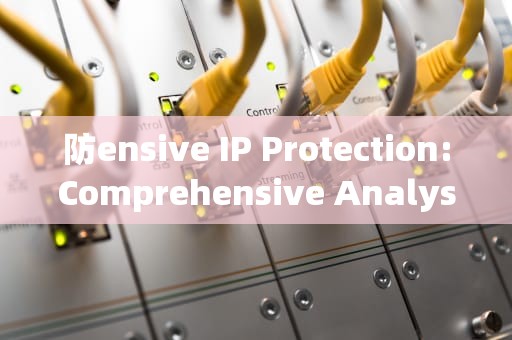本文目录导读:

In the digital age, IP addresses play a pivotal role in connecting devices across networks, enabling communication, and ensuring the integrity of data. However, the widespread use of IP addresses has also made them a target for cyber attackers. From malicious actors to well-organized cybercriminal groups, attackers are constantly seeking ways to exploit vulnerabilities in IP address management. In this article, we will delve into the concept of defensive IP protection, exploring its importance, implementation strategies, and the challenges it faces in today's interconnected world.
Defensive IP protection refers to the measures and strategies employed to safeguard IP addresses from unauthorized access, misuse, and potential attacks. IP addresses are unique identifiers assigned to devices on a network, and they form the backbone of internet communication. However, without proper protection, these addresses can become a liability, as attackers can exploit them to disrupt services, steal data, or launch distributed denial-of-service (DDoS) attacks.
Defensive IP protection encompasses a wide range of techniques, from simple firewalls to complex network security systems. The goal is to ensure that IP addresses remain secure, even in the face of evolving cyber threats.
In an era where cyber threats are becoming increasingly sophisticated, the importance of defensive IP protection cannot be overstated. Here are some key reasons why IP protection is essential:
Preventing DDoS Attacks: DDoS (Distributed Denial-of-Service) attacks are a common cyber threat that aims to disrupt a service's normal operation by overwhelming it with excessive traffic. Without proper IP protection, attackers can easily target specific IP addresses, leading to service disruptions and financial losses.
Protecting Critical Systems: Many critical systems, including servers, databases, and industrial control systems, rely on IP addresses for their operation. A compromised IP address can lead to data breaches, operational downtime, and even physical damage to infrastructure.
Ensuring Compliance: In industries such as healthcare, finance, and government, compliance with regulatory standards is mandatory. IP protection is often a key component of compliance strategies, ensuring that systems are secure and resilient against attacks.
Securing Personal Devices: Even though IP addresses are typically managed at the network level, they can still be exploited by malicious actors. Protecting IP addresses helps safeguard personal devices and the data they hold.
Implementing defensive IP protection requires a proactive approach, combining technology, policies, and training. Here are some key strategies to protect IP addresses:
Firewalls are one of the first lines of defense against IP address threats. Properly configuring a firewall can block unauthorized access to specific IP addresses and ports. Key considerations include:
Intrusion detection systems monitor network traffic for suspicious activity and can detect attempts to compromise IP addresses. IDS tools can identify patterns of unusual activity, such as excessive traffic on specific ports or unexpected connections.
Maintaining a whitelist of trusted IP addresses and a blacklist of known malicious IPs can help protect your network. This approach requires regular updates to the lists to account for new threats.
Network Address Translation (NAT) is a common method for hiding internal IP addresses behind public ones. However, NAT can also be exploited by attackers to target specific devices. To mitigate this risk, it's essential to enable NAT traversal for IP protection, allowing traffic to flow between the public IP and the protected device.
Establishing clear firewall rules and policies is crucial for IP protection. For example:
Dynamic IP addressing can be a double-edged sword. While it enhances security by making IP addresses harder to predict, it also introduces vulnerabilities if not managed properly. To protect dynamic IPs:
Encrypting traffic and using Virtual Private Networks (VPNs) can add an extra layer of security to IP protection. VPNs, in particular, can help hide the source of traffic, making it more difficult for attackers to target specific devices.
As cyber threats continue to evolve, so do the challenges associated with IP protection. Here are some of the key challenges:
Dynamic IP Addressing: Dynamic IPs are harder to predict and monitor, making them a target for attackers. Organizations must balance the benefits of dynamic addressing with the risks of IP compromise.
Distributed DDoS Attacks: Modern DDoS attacks often involve multiple malicious sources, making it difficult to identify and mitigate the threat. This requires advanced detection and response mechanisms.
NAT Transformations: NAT can be used to hide IP addresses, but it also introduces complexity in IP protection. Organizations must carefully configure NAT settings to ensure that IP addresses are protected without compromising network performance.
Threat Intelligence: Staying ahead of cyber threats requires constant updates and intelligence. Organizations must invest in threat intelligence tools and regularly review their IP protection strategies to address emerging risks.
Defensive IP protection is a critical component of modern cybersecurity strategies. By implementing robust measures, such as firewall configuration, IDS, and dynamic IP management, organizations can safeguard their IP addresses from exploitation. However, the challenges posed by dynamic IP addressing, DDoS attacks, and NAT transformations require a proactive and adaptive approach. As cyber threats continue to evolve, staying informed and staying ahead of attackers will be essential for protecting IP addresses and ensuring the security of critical systems.
In conclusion, defensive IP protection is not just about securing IP addresses; it is about securing the future of the internet. By adopting best practices and staying vigilant, organizations can build a resilient network that withstands the evolving threats of today's digital landscape.
随着互联网的普及和信息技术的飞速发展台湾vps云服务器邮件,电子邮件已经成为企业和个人日常沟通的重要工具。然而,传统的邮件服务在安全性、稳定性和可扩展性方面存在一定的局限性。为台湾vps云服务器邮件了满足用户对高效、安全、稳定的邮件服务的需求,台湾VPS云服务器邮件服务应运而生。本文将对台湾VPS云服务器邮件服务进行详细介绍,分析其优势和应用案例,并为用户提供如何选择合适的台湾VPS云服务器邮件服务的参考建议。

工作时间:8:00-18:00
电子邮件
1968656499@qq.com
扫码二维码
获取最新动态
